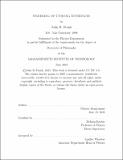Ordering of Curving Interfaces
Author(s)
Frank, John R.
DownloadThesis PDF (23.50Mb)
Advisor
Kardar, Mehran
Terms of use
Metadata
Show full item recordAbstract
Curved surfaces are fundamental parts of living systems. This thesis examines how materials can order on curving interfaces, resulting in shape changes and pattern formation. Many phenomena that are well-studied in flat space display new behavior when lifted onto a deformable surface: liquid crystals buckle membranes into peaked shapes, diffusing particles can sense curvature and localize patterns, and anisotropic growth can form branching structures over many scales.
The systems I study include fluid membranes and growing solids. My framework connects the study of liquid crystals to cytoskeletons of living cells, and provides tools for understanding the machinery of vesicles as well as the remodeling of entire cells. Orientational order plays a central role on these surfaces. Topological defects in an orientation field are an area of intense historical and on-going interest. This work was published in a paper with my coauthor and advisor Mehran Kardar.
I show that curvature modifies diffusion and can change the spatial patterns generated by Turing instabilities. Turing patterns have been studied extensively on flat substrates. To lift this patterning mechanism onto the highly curved shapes of living systems, we apply tools from perturbation theory and differential geometry to analytically compute modifications to the Laplacian and its normal modes on curved surfaces. This extends the framework of differential geometry to understand chemical concentrations diffusing on biological interfaces. In this thesis, I expand upon a paper I published with my coauthors Jemal Guven, Mehran Kardar, and Henry Shackleton.
I conclude with initial results from a new cellular automaton of anisotropic solid growth, which generates tree-shaped morphologies. This suggests that branching structures in botanical trees may result from a simple, universal growth process. Topological defects naturally appear at the branch points of these structures in simulations and in nature. By expanding biophysics from its historical focus on the molecular realm to include macroscopic living solids, we may eventually learn to save our global forests and engineer growing structures on Earth and beyond.
Date issued
2023-06Department
Massachusetts Institute of Technology. Department of PhysicsPublisher
Massachusetts Institute of Technology